The increased activity of TRPV4 channel in the astrocytes of the adult rat hippocampus after cerebral hypoxia/ischemia
- PMID: 22761937
- PMCID: PMC3384594
- DOI: 10.1371/journal.pone.0039959
The increased activity of TRPV4 channel in the astrocytes of the adult rat hippocampus after cerebral hypoxia/ischemia
Abstract
The polymodal transient receptor potential vanilloid 4 (TRPV4) channel, a member of the TRP channel family, is a calcium-permeable cationic channel that is gated by various stimuli such as cell swelling, low pH and high temperature. Therefore, TRPV4-mediated calcium entry may be involved in neuronal and glia pathophysiology associated with various disorders of the central nervous system, such as ischemia. The TRPV4 channel has been recently found in adult rat cortical and hippocampal astrocytes; however, its role in astrocyte pathophysiology is still not defined. In the present study, we examined the impact of cerebral hypoxia/ischemia (H/I) on the functional expression of astrocytic TRPV4 channels in the adult rat hippocampal CA1 region employing immunohistochemical analyses, the patch-clamp technique and microfluorimetric intracellular calcium imaging on astrocytes in slices as well as on those isolated from sham-operated or ischemic hippocampi. Hypoxia/ischemia was induced by a bilateral 15-minute occlusion of the common carotids combined with hypoxic conditions. Our immunohistochemical analyses revealed that 7 days after H/I, the expression of TRPV4 is markedly enhanced in hippocampal astrocytes of the CA1 region and that the increasing TRPV4 expression coincides with the development of astrogliosis. Additionally, adult hippocampal astrocytes in slices or cultured hippocampal astrocytes respond to the TRPV4 activator 4-alpha-phorbol-12,-13-didecanoate (4αPDD) by an increase in intracellular calcium and the activation of a cationic current, both of which are abolished by the removal of extracellular calcium or exposure to TRP antagonists, such as Ruthenium Red or RN1734. Following hypoxic/ischemic injury, the responses of astrocytes to 4αPDD are significantly augmented. Collectively, we show that TRPV4 channels are involved in ischemia-induced calcium entry in reactive astrocytes and thus, might participate in the pathogenic mechanisms of astroglial reactivity following ischemic insult.
Conflict of interest statement
Figures
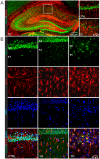
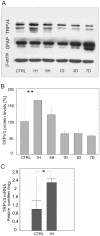
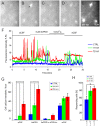
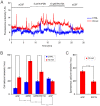
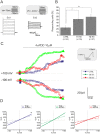
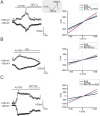
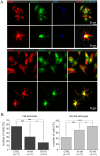
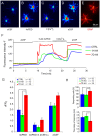
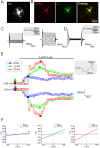
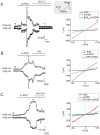

Similar articles
-
Expression and functional characterization of transient receptor potential vanilloid-related channel 4 (TRPV4) in rat cortical astrocytes.Neuroscience. 2007 Sep 21;148(4):876-92. doi: 10.1016/j.neuroscience.2007.06.039. Epub 2007 Jul 17. Neuroscience. 2007. PMID: 17719182
-
Involvement of TRPV4 channels in Aβ(40)-induced hippocampal cell death and astrocytic Ca(2+) signalling.Neurotoxicology. 2014 Mar;41:64-72. doi: 10.1016/j.neuro.2014.01.001. Epub 2014 Jan 20. Neurotoxicology. 2014. PMID: 24457011
-
Prolonged high fat/alcohol exposure increases TRPV4 and its functional responses in pancreatic stellate cells.Am J Physiol Regul Integr Comp Physiol. 2013 May 1;304(9):R702-11. doi: 10.1152/ajpregu.00296.2012. Epub 2013 Feb 27. Am J Physiol Regul Integr Comp Physiol. 2013. PMID: 23447134 Free PMC article.
-
[Research progress of TRPV4 and cerebral ischemic reperfusion injury].Sheng Li Xue Bao. 2015 Oct 25;67(5):527-32. Sheng Li Xue Bao. 2015. PMID: 26490071 Review. Chinese.
-
Astrocytic TRPV4 Channels and Their Role in Brain Ischemia.Int J Mol Sci. 2023 Apr 12;24(8):7101. doi: 10.3390/ijms24087101. Int J Mol Sci. 2023. PMID: 37108263 Free PMC article. Review.
Cited by
-
Stroke and the neurovascular unit: glial cells, sex differences, and hypertension.Am J Physiol Cell Physiol. 2019 Mar 1;316(3):C325-C339. doi: 10.1152/ajpcell.00333.2018. Epub 2019 Jan 2. Am J Physiol Cell Physiol. 2019. PMID: 30601672 Free PMC article.
-
Ca2+ Signalling and Hypoxia/Acidic Tumour Microenvironment Interplay in Tumour Progression.Int J Mol Sci. 2022 Jul 2;23(13):7377. doi: 10.3390/ijms23137377. Int J Mol Sci. 2022. PMID: 35806388 Free PMC article. Review.
-
Detection of TRPV4 channel current-like activity in Fawn Hooded hypertensive (FHH) rat cerebral arterial muscle cells.PLoS One. 2017 May 4;12(5):e0176796. doi: 10.1371/journal.pone.0176796. eCollection 2017. PLoS One. 2017. PMID: 28472069 Free PMC article.
-
TRP Channels in Stroke.Neurosci Bull. 2024 Aug;40(8):1141-1159. doi: 10.1007/s12264-023-01151-5. Epub 2023 Nov 23. Neurosci Bull. 2024. PMID: 37995056 Free PMC article. Review.
-
Transient receptor potential vanilloid 4 mediates hypotonicity-induced enhancement of synaptic transmission in hippocampal slices.CNS Neurosci Ther. 2013 Nov;19(11):854-62. doi: 10.1111/cns.12143. Epub 2013 Jul 4. CNS Neurosci Ther. 2013. PMID: 23826708 Free PMC article.
References
-
- Chvatal A, Anderova M, Neprasova H, Prajerova I, Benesova J, et al. Pathological potential of astroglia. Physiol Res. 2008;57:S101–110. - PubMed
-
- Verkhratsky A, Anderova M, Chvatal A. Differential calcium signalling in neuronal-glial networks. Front Biosci. 2009;14:2004–2016. - PubMed
-
- Nedergaard M, Rodriguez JJ, Verkhratsky A. Glial calcium and diseases of the nervous system. Cell Calcium. 2010;47:140–149. - PubMed
-
- Latour I, Hamid J, Beedle AM, Zamponi GW, Macvicar BA. Expression of voltage-gated Ca2+ channel subtypes in cultured astrocytes. Glia. 2003;41:347–353. - PubMed
Publication types
MeSH terms
Substances
LinkOut - more resources
Full Text Sources
Other Literature Sources
Miscellaneous

